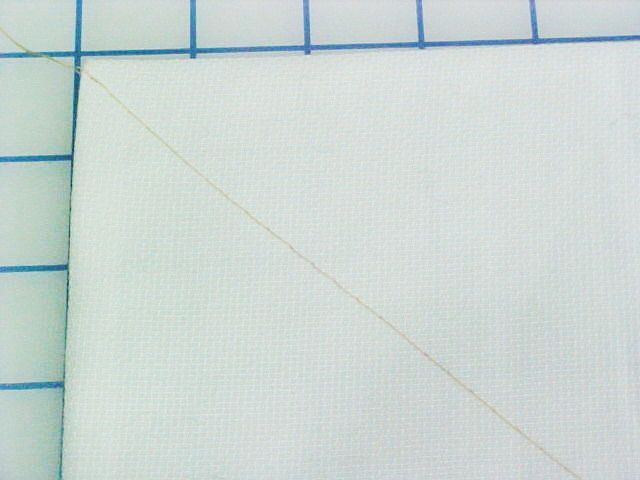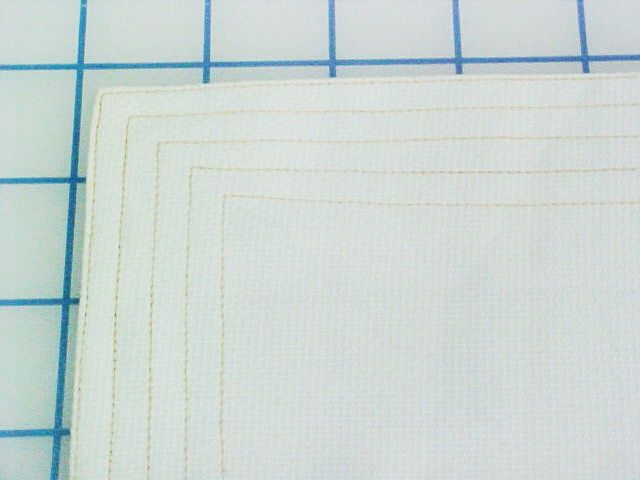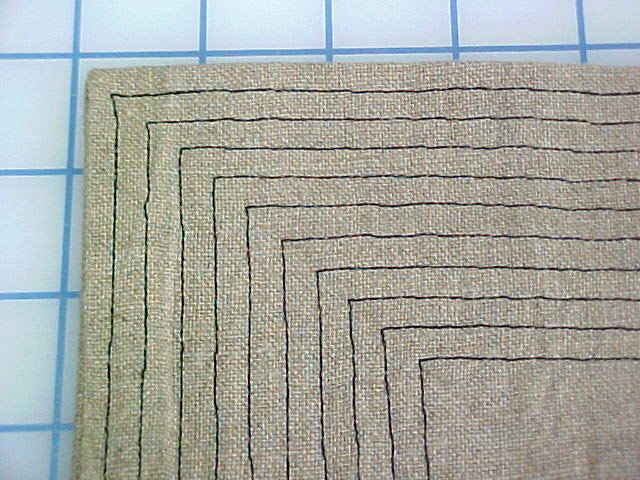
Lately, I’ve found echo stitching on numerous designer garments. I’ve seen it on collars, cuffs, and front plackets. Besides being a great design detail, it is also a great way to discipline dimensional fabric that doesn’t press flat. I find it easier to echo-stitch after the section of the garment is completed. Echo-stitch a collar before it is sewn to the neck band or garment. But, echo-stitch a cuff or front band after the garment is completed. I recommend using 100-percent cotton thread and a no. 11 quilting needle. It will keep the garment reasonably flat with the numerous rows of stitching. There two ways to finish the threads: Pull them to the wrong side and knot; leave long thread tails, thread a needle, and weave them between layers of the garment area. This is especially nice if both layers of the garment are visible.
A great way to have an even width between stitching rows is to use the right edge of your presser foot as a guide.
To turn the echo stitching at a corner and maintain the correct angle, complete the following four steps. The collar on the garment shown has a right angle at the front corners. The same principle applies if the collar had a sharper corner.
1. Hand-press a crease at a 45-degree angle at both short edges of the collar. Don’t press this crease with an iron or use a marking pen because each could leave a permanent mark after the echo stitching is completed. If you are working with a sharper, pointed collar, match the vertical short edge to the long horizontal collar edge, then finger-press the crease.

2. Machine-baste using a light color or white thread along the foldline. Leave long thread tails, and don’t knot or backstitch at the ends of the basting stitch. Avoid using highly contrasting thread (even though it might be easier to see), because the intense color could leave a mark as the thread is removed.

3. Echo-stitch the collar. Starting at the raw edge of the collar, stitch parallel to the vertical short side using the right side edge of your presser foot as your guide. Once your needle reaches the diagonal basting stitch, with your needle in the down position, turn the collar, continuing to stitch along the horizontal outer edge of the collar, turning again at the opposite corner and stitching down the other front edge.

4. Echo-stitch a presser foot width away. If you like your echo stitching rows closer together, switch to a ¼-inch foot. When your needle hits the diagonal basting stitching, turn and continue stitching. Keep your stitching parallel to the original row at all times until your needle hits the opposite diagonal basting stitch, turn again, and continue stitching.
In observing echo stitching in ready-to-wear, I found five to seven rows of stitching, but, the echo stitching could have continued until the entire collar was covered, turning each time at the diagonal basting stitching line.
Once the echo stitching is completed, the basting stitch is removed, and the garment is pressed to set the stitches. In the example below, I’ve used contrasting thread so that it’s easier to see. Normally, you would baste in a light-colored or matching thread.

As you can see, stitching through heavier fabrics can cause echo stitching that looks askew.
In ready-to-wear, echo-stitched garments are stitched with tone-on-tone threads to help mask this problem.
There you have it! What do you think of echo stitching? Have you used this type of stitch in your garments?






































Thank you for this informative article. It was enlightening!
Great directions and photos. Could you give a couple of examples of the type of fabric you would describe as "dimensional'?
I've used it to control facings and lapels that just wouldn't lay right. It's also possible to add curvature to a collar by careful feeding of the fabric while stitching. (Think pad-stitching, but by machine.)
It's a nice way to add some style to a plain garment while retaining its mix-and-match versatility. Use same-color thread, and follow pocket edges, necks, hems, anywhere the fabric is doubled.
This is the technique I use to "quilt" two layers of fabric to a very thin padding on the power bar of a bra pattern. This gives a bit more lift and support for a larger cup size.
Louise, I'm glad you added the comment that using a high contrast thread could result in a wonky look because that was my impression of the first photo. I have used this technique but only using one of my old Singer straight stitch machines. With my zig zag machine, a grand old Bernina 930, the stitching looks like your photo.
I used the same technique on a heavy knit sleeveless jacket. I stitched the mandarin collar, front and pocket tops/back belt. I was frequently complimented on my trapunto work even though I did not add any padding between the lines of stitching.
WOW! This brought back memories!
I did this in Junior High School in our Home Ec class for a potholder.
Received an A+ from the teacher! LOL!
Thanks for the great tip!
I learned echo stitching from my grandmother as a quilting technique. On clothing I've used it for decorative effects and to hold facings in place. My favorite use was on a shift dress made of fabric just a bit too light to hang properly. I used echo stitching on the deep hem which gave the bottom of the dress just enough extra body to hold the skirt in place, similar to using a weight chain in the hem of a jacket.
I love this look. I probably could have figured out how to do it myself, but might never have thought to. Might just try it on the jacket I have cut out now.
Have used this treatment for many tears in quilting and ,clothing a great tip, and thank you for sharing.
As a long time experienced seamstress who has many times used contrasting color threads, your sample is an insult to your Threads magazine. What a shame that you did not take the time to stitch in straight lines or learn how to turn a corner correctly.
This would like nice on linen for clothing or table linens. Thanks for sharing.
Thanks for the info. I never thought to put in a basting stitch on the 45 degree. Nice and easy that way
I would never let work,of this quality leave my sewing room. Also it would be much better to embellish the fabric and the cut out the pattern piece, unless this make the piece too stiff to handle.
The full article has a quote next to the natural linen sample showing what can happen using a heavier fabric.
"As you can see, stitching through heavier fabrics can cause echo stitching that looks askew. In ready-to-wear, echo-stitched garments are stitched with tone-on-tone threads to help mask this problem."
The white pique fabric shows the 45 degree stitching to help turn as you get to the corner. The color even in the white examples, in the finished garment, I would have used tone on tone color. The color thread was used so the camera can pick up the technique.
Hope this helps why you see what can happen when using thicker or dimensional fabric are used
Louise
Thank you Louise for for sharing your valuable technique. For years I have relied on the corner itself as guide, so many ripping years later I found a foolproof way to sew echo stitches on items that have corners. I have used this kind of stitching as embellishments on sleeves and tunic hems.
Wow -- this brought back memories. My troup leader had us do echo stitching as a way to learn to handle a sewing machine. This was centuries ago in 4-H. I remember being in tears over mine! I like the idea of adding stitching to a deep hem to embellish and add weight and stiffness. I look forward to trying this on cotton.
Any special tips for a scalloped hem? It might be just too cute. Maybe I'll save for a slightly different hem on a straight skirt -- when I don't want anything that's overly eyecatching.
Great tutorial. But I'd suggest a different needle. A quilting needle is not the sharpest, it's actually a bit ball point, to handle the batting without pushing it through to the other side of the quilt sandwich. A sharp topstitch, with it's extra sharp tip and longer eye would give straighter penetration in heavy fabrics. I would bet this machine had a horizontal rotary hook as well... a vertical hook, with it's naturally straighter stitch quality would look even better. A rotary has an extra half twist in ever stitch because of the vertical nature of the needle thread meeting up and going round the horizontally carried bobbin thread! This type of stitching also looks lovely done with the double or reinforcing stitch!
Boy, what rude comments, user-248785 and LizKelley. You didn't deserve the polite response you got from Ms. Cutting. Thank you, Louise, for showing us this. BTW, today I used another of your techniques that I learned here and it worked brilliantly. Thank you!
As always Louise, you never disappoint, I have learned so many neat tricks, shortcuts and expertise from you and continue to do so. No matter how good one might think they are, under scrutiny their work is never as perfect as they think, as for LizKelley (who by the way is terrible at grammar and typing skills) and user-248785 if they're such perfectionist why are they even lurking on Threads, they already know it all and are perfect. For those of us that still want to learn new tricks you are so appreciated. I Look forward to many more videos, patterns, lessons, etc. from you, your always there when I need you - Thank you for being YOU!
Thank you Louise for another GREAT lesson. You are the BEST!!!!!!!!